Book contents
- Frontmatter
- Contents
- List of tables and figures
- List of abbreviations
- Acknowledgements
- Introduction
- Dedication
- 1 Industrial legislation and the rise of permanent employer associations 1890–1906
- 2 The Higgins era 1907–1920
- 3 Rival shops 1921–1929
- 4 Depression and recovery 1930–1939
- 5 War and government executive action 1940–1949
- 6 Consolidation 1950–1959
- 7 The National Employers' Associations 1960–1972
- 8 Confederation 1973–1988
- 9 Models of national employer co-ordination
- Appendices
- Bibliography
- Records of organisations
- Index
2 - The Higgins era 1907–1920
Published online by Cambridge University Press: 05 November 2011
- Frontmatter
- Contents
- List of tables and figures
- List of abbreviations
- Acknowledgements
- Introduction
- Dedication
- 1 Industrial legislation and the rise of permanent employer associations 1890–1906
- 2 The Higgins era 1907–1920
- 3 Rival shops 1921–1929
- 4 Depression and recovery 1930–1939
- 5 War and government executive action 1940–1949
- 6 Consolidation 1950–1959
- 7 The National Employers' Associations 1960–1972
- 8 Confederation 1973–1988
- 9 Models of national employer co-ordination
- Appendices
- Bibliography
- Records of organisations
- Index
Summary
The previous chapter reviewed legislative developments following the strikes of the 1890s. These developments, which included the enactment of compulsory arbitration by three parliaments and some form of minimum wage machinery in all the mainland states, caused employers to coalesce with the same intensity as did the strikes. Employer federations were formed at the state level and these confederated to form the Central Council of Employers of Australia (CCEA). Because of differences over New Protection – the coupling of arbitration with tariffs – manufacturers formed separate peak organisations at the state and national levels. Employer hostilities resulted in the federal arbitration system remaining circumscribed, the Western Australian system unobtrusive, and the New South Wales system being reduced to a ‘sinking hulk’.
This chapter reviews employer and tribunal developments from 1907, the year in which the Harvester judgement attempted to give practical expression to the New Protection, to 1920, the year in which Prime Minister Hughes' Industrial Peace Act attempted to fragment the monolithic structure and operations of the federal industrial tribunal. The period was one in which Mr Justice Higgins was President of the Commonwealth Court of Conciliation and Arbitration (Arbitration Court). Appointed to the Presidency in 1907, he was re-appointed for a second 7–year term in 1914. He resigned in 1920 before the expiration of his second term in protest against the Hughes initiatives. His High Court judgements supported the expansion of the ‘New Province of Law and Order' of which he was a major architect.
- Type
- Chapter
- Information
- Holding the LineCompulsory Arbitration and National Employer Co-ordination in Australia, pp. 19 - 47Publisher: Cambridge University PressPrint publication year: 1989



